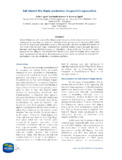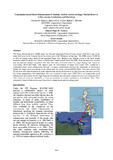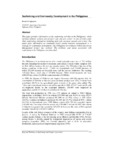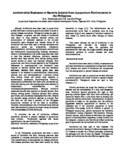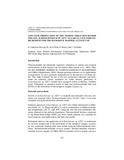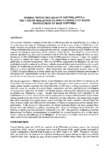Conference Proceedings: Recent submissions
Now showing items 21-40 of 299
-
Small-scale freshwater aquaculture development: Experiences from the Philippines on giant freshwater prawn, milkfish and tilapia
(Japan International Cooperation Agency, 2013-12)The Aquaculture Department of the Southeast Asian Fisheries Development Center (SEAFDEC/AQD) has been promoting a number of programs towards effective dissemination and adoption of science-based aquaculture technologies ... -
Digestibility and effective level of meat and bone meal in formulated diet for milkfish, Chanos chanos Forsskal, grown in fresh and seawater
(Masyarakat Akuakultur Indonesia (MAI), 2015)The efficient level of MBM for good growth and survival of milkfish, Chanos chanos Forsskal, without histological changes in tissues (liver, intestine, muscle, kidney and brain) was determined in both freshwater (FW) and ... -
Series: NOAA technical memorandum; NMFS-F/SPO-168
Development of integrated multi-trophic aquaculture using sea cucumber
(United States Department of Commerce, National Oceanic and Atmospheric Administration, National Marine Fisheries Service, 2017)In Southeast Asian countries, aquaculture production continues to increase. Environmental deterioration associated with water and sediment eutrophication by aquaculture effluent has been problematic, sometimes resulting ... -
Expressions of molt-inhibiting hormone (MIH) and extracellular signal-regulated kinase (ERK) during the molting stages of the giant mud crab, Scylla serrata
(De La Salle University, 2017)Survival and growth of mud crabs and any other crustaceans depend on molting. Molting is influenced by several hormones, two of which are Molt-Inhibiting Hormone {MIH} and a molt promoting hormone, the Extracellular ... -
Morphological development and survival of Philippine silver therapon larvae, Leiopotherapon plumbeus (Kner, 1864) reared under different feeding schemes
(De La Salle University, 2016)Philippine silver therapon, Leiopotherapon plumbeus, locally known as ayungin, is an endemic fish species in the country. The demand for silver therapon remained high despite the decline of its population and commercial ... -
Series: ACIAR Proceedings; No. 90
Review of recommendations from recent SEAFDEC workshops: SICCPPS and AQUACHEM
(Australian Centre for International Agricultural Research, 1999)The Second International Conference on the Culture of Penaeid Prawns and Shrimps (SICCPPS) was convened in Iloilo City by the Southeast Asian Fisheries Development Center (SEAFDEC) on May 14-17 1996 to bring together ... -
Series: ACIAR Proceedings; No. 90
Shrimp aquaculture: the Philippine experience
(Australian Centre for International Agricultural Research, 1999)An overview is presented of the shrimp farming industry in the Philippines, noting that it was established as brackish-water aquaculture as early as 1521, although it took until the 1970s to take off, blooming during the ... -
Paradigm shifts in mangrove rehabilitation in Southeast Asia: Focus on the Philippines
(Department of Environment and Natural Resources - Ecosystems Research and Development Bureau (DENR-ERDB), 2014)Mangrove rehabilitation has a long history in the Philippines dating back to the 1930s. The standard practice is the planting of bakhaw Rhizophora propagules by paid community members (or volunteers) in seafront sites ... -
Salt tolerant Nile tilapia production: Prospects in aquaculture
(Rajiv Gandhi Centre for Aquaculture (MPEDA), 2016)In the Philippines, salt tolerant Nile tilapia strains have been developed and promoted for culture to increase tilapia production in brackishwater pond systems previously dedicated for milkfish and/or penaeid shrimp ... -
Aquaculture-based restoration and stock enhancement of tiger shrimps in the Philippines
(Training Department, Southeast Asian Fisheries Development Center, 2016)In central Philippines, the Aquaculture Department of the Southeast Asian Fisheries Development Center (SEAFDEC/AQD), with strong collaboration and support from the Research Institute for Humanity and Nature (RIHN) of ... -
Fishery resource enhancement: An overview of the current situation and issues in the southeast Asian region
(Training Department, Southeast Asian Fisheries Development Center, 2016)The total global production from capture fisheries has plateaued since the mid 90s. This stagnation in production or reduced productivity of the world’s coastal and marine wild fisheries is caused by overfishing and ... -
SEAFDEC/AQD stock enhancement initiatives: Release strategies established
(Training Department, Southeast Asian Fisheries Development Center, 2016)SEAFDEC/AQD’s Stock Enhancement Program started in 2001 with the first stock enhancement initiative on mud crab Scylla spp. funded by the European Commission. This was followed by another stock enhancement program in 2005 ... -
Community-based stock enhancement of abalone, Haliotis asinina in Sagay marine reserve: Achievements, limitations and directions
(Training Department, Southeast Asian Fisheries Development Center, 2016)The Sagay Marine Reserve (SMR) under the National Integrated Protected Area System (NIPAS) is one of the many reef areas in the Visayan Sea in the central part of the Philippine archipelago. The SMR covers 32,000 ha or 59% ... -
Series: ACIAR Working Paper;No. 54
Mud crab hatchery and grow-out status in the Philippines
(Australian Centre for International Agricultural Research, 2004)Interest in mud crab aquaculture is increasing throughout the Philippines because of its demand both in local and export markets. Mud crab culture started as low-density polyculture with fish or shrimp using wild crab ... -
Requirements of juvenile sea bass, Lates calcarifer Bloch, for lysine and arginine
(International Foundation for Science, 1993)The dietary requirements of juvenile sea bass for the essential amino acids, lysine and arginine, were studied. Fish (Initial average weight in Lysine (Study 1) and Arginine (Study 2) experiments were 13.1 g and 2.5 g, ... -
Seafarming and community development in the Philippines
(Network of Aquaculture Centres in Asia-Pacific, 2002)This paper provides information on the seafarming activities in the Philippines, which includes milkfish, seabass and grouper cage and pen culture. It also provides some other seafarming alternatives including mud crab, ... -
Qualitative and quantitative comparison of bacterial flora associated with hatchery-reared and wild-caught shrimp postlarvae
(ASIARESIST, 2005)Because of high mortality recorded in pond-reared shrimps due to luminescent vibriosis infection, a study was conducted to determine if postlarvae (PLs) could be major sources of luminescent bacteria (LB). Batches of ... -
Antimicrobial resistance in bacteria isolated from aquaculture environments in the Philippines
(ASIARESIST, 2005)Antibiotics have been used in aquaculture as feed additives to promote growth and added in water to prevent disease occurrence. Therapeutic doses are used to treat diseases. Long-term use and misuse of antibiotics may ... -
Low-cost production of the marine thraustochytrid isolate, Schizochytrium sp. LEY7 as larval live feed enrichement for the mangrove snapper, Lutjanus sp.
(Laboratory of Aquaculture & Artemia Reference Center, Ghent University, 2013)This study demonstrates the potential of low-cost production substrates in mass producing the Schizochytrium sp. LEY7 for maximum DHA production. High biomass yield was achieved by optimizing the culture conditions ... -
Marine protected areas in the Philippines: The case of Malalison island in community-based management of reef fisheries
(UNESCO Office, 2004)The extensive Philippine coastline of more than 22,540 k m provides the natural habitat of a variety of flora and fauna that make the Philippine archipelago one of the centers of marine biodiversity in the world. Resource-use ...









